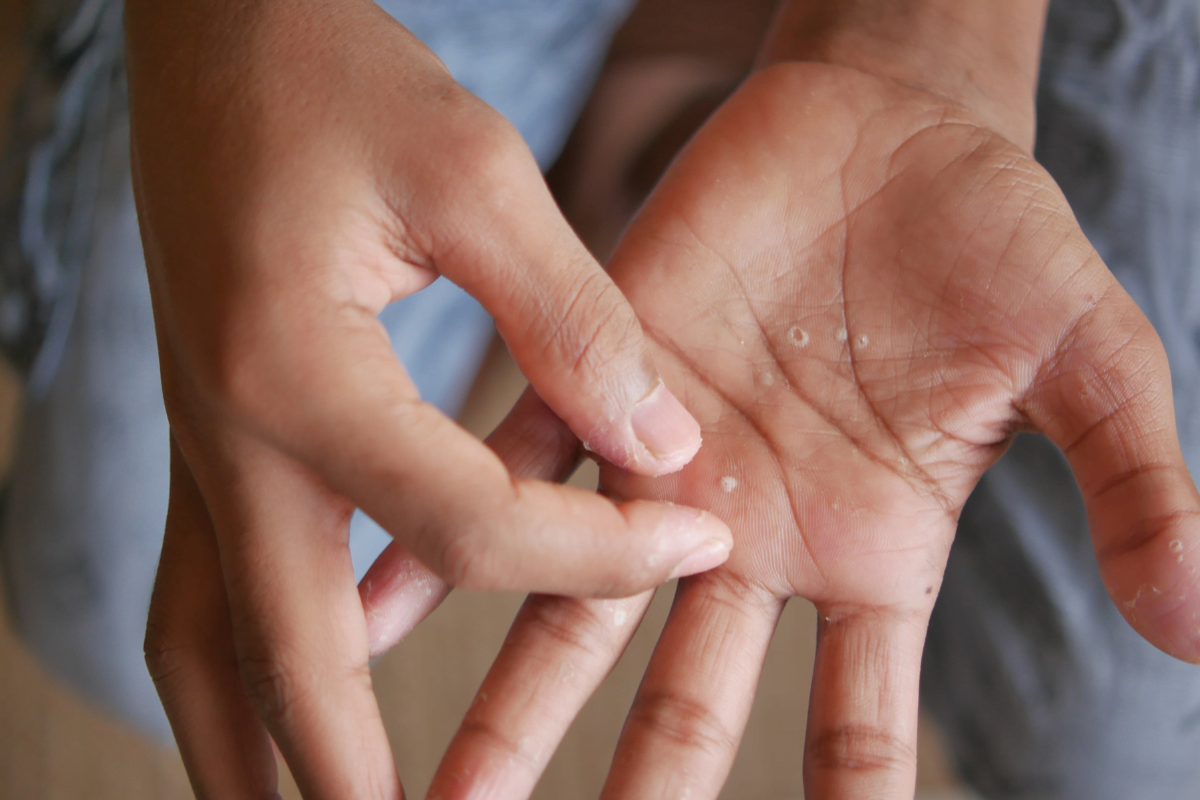Dyshidrotic eczema, a type of dermatitis characterized by small and itchy blisters on the edges of the fingers, toes, palms, and soles, can be a frustrating condition to manage.
Many people wonder if dyshidrotic eczema is contagious and how stress can influence its occurrence. In this article, we will be going to discuss these concerns, dig deep into the symptoms and causes, and explain effective treatments. Also, this article aims to clarify whether dyshidrotic eczema is contagious, explore the significant impact of stress on the condition, and address the common misconception that it is an allergic reaction to gel polishes or substances used during manicures.
Is Dyshidrotic Eczema Contagious?
No, dyshidrotic eczema is not contagious. An infection does not cause it and cannot be spread from person to person. The condition’s exact cause is unknown, but it is believed to be linked to factors such as stress, allergies, damp hands and feet, and exposure to certain substances like nickel or cobalt. While the condition can be uncomfortable and sometimes painful, it poses no risk of transmission to others. Managing triggers and maintaining good skin care can help control the symptoms and reduce flare-ups.
Dyshidrotic eczema commonly affects adults between the ages of 20 and 40, though it can occur at any age. It is more prevalent in women than men. Individuals with a history of atopic dermatitis, hay fever, or allergies are at a higher risk.
People who frequently have their hands or feet in water or are exposed to irritants such as nickel, cobalt, or certain chemicals are also more susceptible. Additionally, those under significant stress or experiencing excessive sweating may be more prone to developing dyshidrotic eczema.
The Role of Stress in Dyshidrotic Eczema
Stress is a significant factor in the exacerbation of dyshidrotic eczema. When an individual’s body experiences stress, it can cause a cascade of immune responses that may lead to the development of stress bumps on fingers and other areas affected by dyshidrotic eczema.
Studies have shown that people exposed to high stress are more likely to have episodes of flare-ups, especially of this condition. Hence, managing stress through various techniques such as mindfulness, exercise, and relaxation can help lessen the frequency and severity of outbreaks.
Causes of Dyshidrotic Eczema
The exact root of dyshidrotic eczema remains unclear. However, there are several factors pointed out to contribute to its development. These include:
Genetic Predisposition
A history of eczema or other allergic conditions in the family increases the likelihood of developing dyshidrotic eczema. This genetic predisposition means that individuals with close relatives who have experienced eczema or other atopic diseases, such as asthma or hay fever, have a higher risk of developing dyshidrotic eczema. The genetic factors involved can affect the immune system’s response and the skin’s barrier function, making the skin more susceptible to irritation and the formation of itchy blisters characteristic of dyshidrotic eczema.
Allergens
Exposure to certain allergens, such as nickel or cobalt, can trigger symptoms of dyshidrotic eczema. These metals are commonly found in everyday items like jewelry, electronics, and even some foods. When an individual’s skin comes into contact with these allergens, it can provoke an immune response, leading to inflammation and the development of blisters. Identifying and avoiding these triggers is crucial for managing the condition and preventing flare-ups.
Sweating
Excessive sweating, especially on the hands and feet, can contribute to flare-ups of dyshidrotic eczema. Sweating can create a moist environment that irritates the skin and compromises its barrier function. This increased moisture can lead to maceration of the skin, making it more prone to irritation and infection. For individuals with dyshidrotic eczema, managing sweat through proper hygiene, wearing breathable fabrics, and using antiperspirants can help lessen the frequency and also the severity of outbreaks.
Stress
Stress is a significant trigger for dyshidrotic eczema because it activates the body’s immune response, leading to increased inflammation and the release of stress hormones such as cortisol. These hormonal changes can disrupt the skin’s natural barrier function, making it more susceptible to irritants and allergens.
Effective Treatments for Dyshidrotic Eczema
Managing dyshidrotic eczema involves a combination of lifestyle changes and treatments. Here are some effective strategies:
Topical Steroids
Topical steroids are typically prescribed to reduce inflammation and itching associated with dyshidrotic eczema. These medications, available in various strengths, help to calm the immune response that leads to the characteristic blisters and discomfort. Applying a dyshidrotic eczema treatment cream containing corticosteroids directly to the affected areas can provide significant relief and speed up the healing process.
Moisturizers
Keeping the skin well-hydrated is crucial in managing dyshidrotic eczema. Regular use of moisturizers, such as petroleum jelly or other emollients, can help maintain skin hydration and create a protective barrier against irritants. These products should be applied frequently, especially after washing hands or coming into contact with water, to lock moisture, as well as prevent the skin from becoming dry and cracked, which can trigger or worsen symptoms.
Avoiding Triggers
Identifying and avoiding triggers is a key aspect of managing dyshidrotic eczema. Individuals with this condition should try to determine what exacerbates their symptoms and take steps to minimize contact with these triggers. For example, wearing gloves when handling metals or using mild, fragrance-free soaps can help reduce the likelihood of flare-ups.
Prescription Medications
In severe cases where topical treatments and lifestyle changes are insufficient, prescription medications may be necessary. Oral medications such as corticosteroids, immunosuppressants, or antihistamines can help control the symptoms of dyshidrotic eczema.
Specific Treatments
On the other hand, specific treatments for dyshidrotic eczema also include the following:
Best Cream for Dyshidrotic Eczema
Selecting the best cream for dyshidrotic eczema involves choosing products with potent anti-inflammatory ingredients. These creams often contain corticosteroids, which help reduce swelling, redness, and itching.
Some over-the-counter options include hydrocortisone cream, but for more severe cases, a dermatologist may prescribe stronger topical steroids.
Athlete’s Foot and Dyshidrotic Eczema on Feet
Dyshidrotic eczema on the feet can be complicated by the presence of an athlete’s foot, a fungal infection. Maintaining proper foot hygiene is also critical to prevent these issues from overlapping and exacerbating each other. Washing your feet, drying them thoroughly, wearing breathable footwear, and changing socks frequently can help manage moisture and reduce fungal growth.
Takeaways
Dyshidrotic eczema can be a challenging skin condition to manage, but understanding its triggers, especially the role of stress, and using appropriate treatments can significantly improve symptoms. While it is not contagious, proper care and avoidance of triggers are crucial. If you suspect you have dyshidrotic eczema, seek medical help to receive a tailored treatment plan and discover the best treatment for your specific needs.
Frequently Asked Questions (FAQs)
How to get rid of dyshidrotic eczema?
To get rid of dyshidrotic eczema, follow a comprehensive treatment plan that includes using prescribed topical steroids to reduce inflammation, moisturizing the skin regularly with products like petroleum jelly to prevent dryness, avoiding known triggers such as certain metals or allergens, and managing stress levels. In severe cases, a dermatologist may prescribe oral medications or other treatments.
How to treat dyshidrotic eczema?
Treating dyshidrotic eczema involves using a dyshidrotic eczema treatment cream containing corticosteroids to reduce itching and inflammation, applying emollients like petroleum jelly to keep the skin hydrated, identifying and avoiding allergens and irritants that can trigger flare-ups, and consulting a doctor for personalized treatment options and following their recommendations.
What is the ICD code for dyshidrotic eczema?
The ICD-10, also known as the International Classification of Diseases 10th revision, is a system utilized by physicians to categorize and encode all diagnoses, symptoms, as well as procedures for diseases. The ICD-10 code for dyshidrotic eczema is L30.1. Healthcare providers use this code to classify and code the diagnosis of dyshidrotic eczema for medical records, billing, and insurance purposes.

